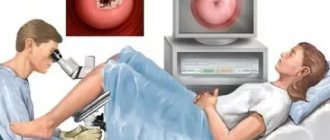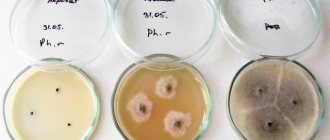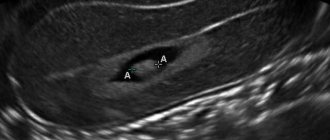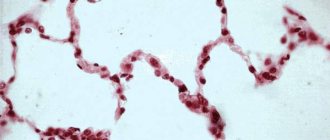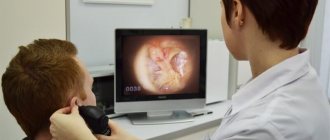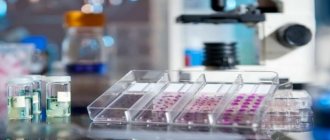What is cervical cytology
The objectives pursued by this research are very diverse. It all depends on what kind of biomaterial was taken and what needs to be found or refuted. In any case, it is assessed whether the collected material corresponds to what is normal for a healthy human individual. This is the configuration of the cytoplasm, their structure and the absence or presence of negative inclusions in each cell studied. Cytology allows you to find abnormalities in biomaterial from the cervix, find cancerous inclusions or abnormal precancerous inclusions preceding it.
Why and how rebirth occurs
Although it has long been proven that cells with altered DNA are formed in the human body all the time, and we are not talking about single cells, but about millions, their transformation into tumor cells does not always occur. The process of aging and cell destruction (apoptosis) is laid down in DNA from the very beginning. This process occurs at the genetic level and is responsible for such cells being removed from the body by self-destruction. But sometimes this kind of self-destruction program fails, which is a prerequisite for the development of a tumor. First, a normal cell becomes atypical, and the next stage may be its degeneration into a cancerous one.
Note! Any organism contains a whole mechanism that is aimed at suppressing cancer transformation; this process is called the “repair system.” This system is necessary for the restoration of cells after a negative impact on it, and this system destroys those incapable of resuscitation (atypical).
If the human body is not all right in terms of health, this means that the repair system is failing. The risk of atypical cells degenerating into cancerous cells is called “oncogenesis.”
Although such atypical cells have signs of a tumor (analysis can show this), they are not cancer yet. Their complete transformation into oncogenic ones will occur slowly and gradually. The stage of degeneration, when minimal signs of cellular mutation (atypia) begin to appear, is a precancerous condition. Sometimes the body can cope with such a pathology on its own, but to do this, it is necessary to remove the negatively influencing factor. Or the transformation process will develop further.
In gynecology
Cytology in gynecology plays a serious role in determining many diseases, not only cancerous tumors. This examination will help to recognize structural transformations in the structure of cells and determine inflammation or infection in the first days or weeks of the disease.
What is cytological analysis - a relatively short, inexpensive and highly accurate way to determine the appearance of atypical cells. Atypical cells in cytology indicate the development of an inflammatory or infectious disease, or changes in the structure of the cells themselves. To check women's health, you need to scrape the cervix. This is especially important if a woman had relatives who died from cancer of the cervix or other part of the genitourinary system. If a woman has previously had cancer, then it is necessary to be examined for the likelihood of relapse at least annually or more often on the recommendation of the attending physician.
Detection of atypical cells
A qualified specialist will tell you what a cytology test in gynecology shows. The most dangerous sign of pathology is the identification of atypical cells with the presence of malignant degeneration. In this case, the result of the cytological analysis will be the reason for performing an oncological search, that is, a diagnosis aimed at detecting cancer will be required, which is probably still at an early stage and does not show any changes in well-being.
Also, in addition to cytology analysis, gynecology also conducts histology studies. The difference between these two types of diagnostics is that during histological examination, doctors study not individual cell accumulations, but tissues of various organs or formations. This analysis usually requires preliminary removal of biomaterial (biopsy, that is, a piece of tissue is pinched off), or even surgical intervention is performed for this.
Preparation for histological analysis requires more effort than cytological examination. Therefore, it is performed much less frequently and only if there are sufficient grounds, while cytology is often prescribed for preventive purposes in order to make sure that the patient is healthy. Let's talk in more detail about how cytology differs from histology in gynecology.
When to take a smear for cytology
The reasons that indicate the need to get tested are varied. The first time the study is recommended is 3 years after the start of sexual activity. Girls over 18 years of age are required to undergo a cytology test annually in order to promptly identify the onset of a deviation. There are also direct indications for which a cytological examination of scrapings from the cervix and cervical canal should be taken unscheduled:
- If you plan to become pregnant in the near future;
- If infertility is in question or is being treated;
- Distortions of the menstrual cycle have been identified and the reasons need to be established;
- Genital herpes has been detected or there is a suspicion that it will appear soon;
- Obesity has been diagnosed and the cause is being sought;
- Suspicion of human papillomavirus;
- Hormonal contraception was taken for a long time;
- Promiscuous sexual intercourse;
- More than two sexual partners at the same time or in a row;
- It is planned to insert an intrauterine device.
In addition, a doctor can prescribe a cytological smear at his own discretion or if he suspects a whole range of diseases.
When should you take a smear test?
In order for every woman to be confident in her health, she must undergo a smear test regularly. But not everyone does this. Therefore, doctors have identified indications for which it is mandatory to visit a specialized doctor. This:
- Menstrual irregularities.
- Infection in the uterus.
- Planning for conception.
- Carrying out the operation.
- Installation of the spiral.
There are also risk groups. When a woman is one of these, she should also regularly visit a gynecologist and have him examined. These are the following groups:
- Obese.
- With diabetes.
- With genital herpes.
When a woman constantly changes sex partners, and also takes hormonal anti-conception drugs, or she simply has a weak immune system, then she should also think about undergoing such tests. You can refuse such examinations only in one case - when a young woman does not have sex and has not had a hysterectomy.
When should you take a smear for cytology?
There are some conditions of the body in which it is necessary to take a smear monthly in order not only to identify atypical cells, but also to monitor the health status of a person at risk:
- There are indirect signs of human papillomavirus;
- Venereal diseases;
- Genital warts;
- Cancer is in remission;
- Genital herpes;
- Severely weakened immunity.
For cervical erosion and human papillomavirus infection, smears must be performed every six months to monitor health and the onset of negative manifestations. It is important to maintain healthy microflora. During pregnancy, the test will have to be carried out three times - during the first visit and registration with the LCD, at 30 weeks, when you need to undergo an examination to receive an exchange card. And at 36 weeks, the last study before the maternity hospital is carried out to identify diseases and try to cure them before birth. In every case when a pregnant woman’s discharge changes sharply, itching and burning appears, you need to consult a doctor.
If the woman is not pregnant, then the test should be taken on day 4-5 of the cycle. During pregnancy - when the doctor says within the specified weeks. Why else do they take a cytological test before the maternity hospital? The presence of sexually transmitted diseases, AIDS or HIV, genital herpes, or life-threatening diseases for the child transfers the mother to a special group. In this case, she will come under the close supervision of specialists and will give birth in the second department of the maternity hospital, where everyone with similar diseases is collected.
Specifics of cytological smears during pregnancy
When examining the cervix in pregnant women, it is necessary to take into account the high level of sensitivity of the cervical epithelium to the level of estrogen.
Natural changes in hormonal levels are accompanied by an increase in the volume of the cervix and the development of physiological hypertrophy of the fibromuscular stroma. Due to this, cervical ectopia develops, which is considered a normal variant only during pregnancy.
A PAP smear during pregnancy is a mandatory test in the first trimester of pregnancy (it is recommended to use liquid-based cytology).
When examining cytological smears in pregnant women, it is recommended to take into account the presence of specific reactive changes in the epithelium during pregnancy.
What material is used in the study?
Cytological research methods involve taking three types of biomaterial in the same way. To collect biomaterial, a brush is passed along the tissue of the cervical canal. Using another similar sterile spatula, a smear is examined in the vagina, and a third one is used to examine a smear from the mouth of the paraurethral ducts.
The biomaterial is sent to the laboratory. There it is placed on glass, stained and the cytoplasm is examined using specialized equipment. Cytological examination of the cervix of the cervical canal, if necessary, is accompanied by another analysis using a Petri dish.
What is a cytological examination
Cytological examination is one of the most popular in oncology. With its help, the doctor assesses the condition of the cellular elements and makes a conclusion about the malignant or benign nature of the neoplasm. The structural features of cells, the cellular composition of organs, tissues, and fluids of the human body are studied. Cytological examination is used in the diagnosis of precancerous diseases and malignant neoplasms of various organs: the cervix and uterine body, breast, thyroid gland, lungs, skin, soft tissues and bones, gastrointestinal tract, lymph nodes, etc. For cytological examination, smears of the vaginal vault are taken and cervix, sputum, urine, exudates from cavities, etc.
How to prepare for a smear test
To conduct cytological studies of a smear, you need to prepare.
You need to refrain from any sexual contact and not use any vaginal products for one or two days before collecting the material. The use of creams, lubricants, suppositories and douching is also prohibited within two days before the day of delivery. You can swim, but without adding medications to the water, which can destroy normal flora, and not in hot water. On the day of the smear test, you cannot visit the toilet 2-3 hours before the appointment, you cannot urinate, wash yourself or use wet wipes for intimate hygiene. You cannot take the test if you experience severe itching in the vagina or an unpleasant-smelling discharge, since the collection of biomaterial is accompanied by microtrauma of the cervix. This can trigger the development of infection in the genital tract. It is important to remember on what day of the cycle it is possible to submit the material for research. You can take the test only on the 4-5th day of the cycle, immediately after your period ends.
Preparation for the biomaterial collection procedure
In order for the result of cervical cytology to be reliable, it is necessary to take into account the rules of preparation for collecting biomaterial. They are as follows:
- Elimination of hygiene procedures in the form of douching (sanitation).
- Abstain from sexual activity for three days before the procedure.
- Temporary refusal to use tampons, vaginal suppositories, tablets, creams and gels.
- Refrain from urinating two hours before taking the material.
In addition, you need to know about the following nuances:
- obtaining a smear from the cervical canal is possible only outside of menstrual bleeding, the optimal period is 10-12 days of the cycle;
- smear cytology will not be reliable in the acute phase of an infectious disease, so it is carried out after a course of therapy;
- intravaginal administration of any kind of medication should be stopped in consultation with the attending physician no less than five days before the procedure for collecting the material.
Additional conditions and rules that the patient must take into account must be clarified with the gynecologist.
Theory for deciphering the results
It is better to entrust the decoding of cytology to a specialist, but sometimes it is necessary to study the data yourself. The level of flora living in different girls can be very different, cytological studies differ. There is a norm, although it is quite difficult to establish its boundaries.
The normal level of leukocytes does not exceed 10 cells per field of view in the urethra, and 30 in the cervix and its canal. In a pregnant woman, these indicators will be greater; the assessment of their characteristic volume depends on the condition of the pregnant woman herself. Types of cytological studies include work with different materials - sputum, mammary gland secretions, amniotic fluid and others, depending on the need to identify the disease. Such studies help to detect positive dynamics in treatment.
The type of epithelium that lines the tissue is also being studied. If you analyze a smear from the vagina or urethra, you can see traces of stratified squamous epithelium. When studying biomaterial from the cervical canal, most of the prismatic epithelium will be depicted; its binucleate cells change their number according to the days of the cycle. But in normal quantities it should not be more than 10 units.
In a normal state, traces of mucus should be found in small quantities in the biomaterial. This component should be in moderation, because both the vagina and the cervical canal secrete it. Large amounts of mucus can be a symptom of bacterial vaginosis. In a normal smear, the flora should be rod-like with occasional inclusions of cocci.
Labeling of test results
The results of the examination are subject to mandatory marking - changes must have a number from 0 to 5. The number 0 is given if the material was collected incorrectly or is of poor quality. It is not suitable for research and must be taken again. Other indicators:
- Normal cells without atypical inclusions;
- There are atypical changes;
- Beginning of dysplastic changes;
- Precancerous cells;
- Ivasive cancer.
Degrees of dysplasia
Dysplastic changes in cervical cells are divided into three large groups. The first stage is considered mild and reflects the appearance and active development of the inflammatory process. The second stage is accompanied by moderate dysplastic changes and signals an increased likelihood of cancer cells appearing. The third stage corresponds to a severe condition of the cells and is diagnosed before the appearance of precancerous cells.
Terms used in diagnosis
When collecting material such as a smear for oncocytology or suspicion of other diseases, liquid cytology of the cervix is performed. This type of research allows you to collect only the material necessary for the study. At the same time, such thin-layer smears will not show whether there are leukocytes in the mucus, inflammation or destroyed cells. This does not allow assessing the cell environment and performing an intermediate stage of the study.
Before taking a smear for cytology of women, you must definitely come to see a doctor and undergo an examination. A cytological examination is not prescribed at the request of the patient, only for direct indications or suspicions of them.
Interpretation of abbreviations and abbreviations
After receiving the research results, you should not try to decipher all the data yourself, much less prescribe treatment. It is better to wait for a consultation with a specialist and entrust all this to him. The main values that may appear on the results form are:
- NILM - absence of malignant cells or lesions in the body;
- AGC—presence of atypical cells in the biomaterial;
- ASC - the presence of atypical cells in the squamous epithelium;
- NOS or US - unclear purpose of cells;
- AIS—endocervical adenocarcinoma;
- CIS - carcinoma;
- SIL - damage to squamous epithelial cells with H - high degree, with L - low degree;
- VaIN—vaginal neoplasia;
- VIN is a neoplasia found in the vulva.
Inflammatory type of smear for cytology - what is it?
The presence of an inflammatory type of cytology smear indicates that inflammation is occurring in the body. If this type of smear was diagnosed, then it is necessary to identify the cause of the inflammation. It can be hidden in a fungal, viral or protozoal infection. Then you need to undergo treatment, which will be prescribed by a specialist after he sees the test results. It is not worth treating with folk remedies or herbs, as this can only waste time and aggravate the disease and the body’s own condition. After the full course of treatment, you need to be re-examined for cure.
What changes are possible?
Benign changes may include:
- Detection of trichomonas, candida fungi, coccal infections, anomalies caused by infection with the herpes virus.
- Cellular atypia provoked by inflammatory reactions: metaplasia, parakeratosis, keratosis.
- Atrophic changes in epithelial cells in combination with inflammation: hyperkeratosis, colpitis, metaplasia.
Dysplastic changes and atypia suggest the following conditions:
- Atypia of unknown origin (ASC-US).
- High risk of presence of cancer cells in the material (HSIL).
- Precancerous atypia: varying degrees of dysplasia.
If cancer cells are detected, it is necessary to prescribe additional examination methods and a subsequent course of therapeutic correction (conservative or surgical treatment) with constant cytological monitoring.
Why is the cervix examined first?
What does a cytology smear show?
The analysis can make it possible to assess the size, shape and number of cells, as well as the nature of their arrangement.
With this test, background cells, precancerous and cancerous, can be seen. This is very helpful in diagnosing cancer in the early stages, when treatment is close to 100 percent. Cytology smear - what does it show?
In the laboratory, the material for cytological analysis of the cervix is carefully assessed. It is checked whether there is enough material for analysis and whether it is applied too thin or thick. It is important to check before starting the test that the material is not contaminated with mucus, blood, semen or other liquid. Poor cervical cytology will also occur in the presence of inflammatory exudate in the biomaterial.
Cytological diagnosis determines the presence of atypical cells or other pathologies in the body. A cytological smear does not diagnose diseases, but with the help of additional studies it becomes possible to make accurate diagnoses, such as vaginitis, vaginosis, cancer, Trichomonas, genital herpes and other diseases.
Additionally, the patient usually undergoes a blood test, which can confirm or deny the presence of inflammation in the body. Mucus in cytology is normal if it is in the body in small quantities. The normal number of indicators can be determined by a gynecologist.
A smear for cervical cytology has a transcript that can only be carried out by a specialist. Independent interpretation of the results may result in an incorrect diagnosis and treatment, which means taking useless drugs when the body is healthy. There may also be the opposite result - without understanding what the analysis shows, a person does not detect the onset of a malignant tumor and misses the time when it was possible to quickly get rid of the disease.
Decoding using the Betsed method
In the transcript of a cytological examination of the cervix using this method, one can see a low or high degree of transformation. Low will show koilocytosis and CIN I. With a high degree, CIN II or III can be detected, and carcinoma can also be detected, which correlates with Pap smear grade 3-5. A description of the obtained values with an explanation will either be at the end of the sheet, or it must be obtained from the specialist who prescribed the analysis.
The results may have the following values:
- NILM—normal cell state;
- ASCUS - atypical inclusions of unknown etiology;
- LSIL—small number of cells with transformations, HSIL—increased volume;
- High-grade SIL - squamous cell carcinoma;
- AGC - low-quality glandular inclusions.
Interpretation of the Papanicolaou method PAP test
Analysis in the form of cervical cytology is performed for girls over 21 years of age.
The results make it possible to identify cervical cancer or dysplasia in the early stages. You can get results at the clinic after 1-2 weeks. If you do the analysis through a private laboratory, you can get the finished analysis after a couple of days. A cytology smear showed inflammation, what does this mean - the development or appearance of inflammatory processes, the cause may be different. This is both a protozoal disease and a viral or fungal infection. Treatment is carried out in accordance with the doctor’s prescription, depending on the diagnosis.
Cell transformations that can occur with this type of test are divided into five different classes:
- Class I - normal cells without pathological changes;
- Class II - an inflammatory process in the cervix or vagina, accompanied by minor cellular changes;
- Class III - some cells have changes in the nucleus, there is a suspicion of the formation of malignant cells;
- Class IV - some of the cells have obvious signs of malignant formations;
- Class V - the appearance of a malignant tumor with a significant number of cancer cells not only at the site of tumor formation, but also nearby.
It is important to remember that the white blood cell count in a pregnant woman’s blood will be higher than what should be normal in a non-pregnant woman. In addition, in some cases it is necessary to repeat the study or conduct other clarifying diagnostic studies.
Important! Glandular cells of a benign nature are a normal condition of a woman’s body. This is considered a normal option in girls with a normal menstrual cycle.
When is a cytological examination prescribed?
In most cases, doctors - therapists, gynecologists, oncologists and other specialists - resort to cytological diagnostics when a tumor disease is suspected.
The cytological method is used to study tumors in various organs - skin, mammary gland, lungs, mediastinum, liver, kidneys, retroperitoneal formations, thyroid gland, prostate gland, testicle, ovaries, lymph nodes, tonsils, salivary glands, soft tissues, bones, etc. .
Cytological studies are most widespread in the field of gynecology. This is an affordable and fast screening method that has proven effective in diagnosing precancerous diseases and early cervical cancer.
There are often cases when cytological examination helped to detect cancer of the stomach, lung, bladder, etc. at the earliest stages, when X-ray and endoscopic examinations did not reveal any changes.
During the treatment of a tumor disease, it is necessary to constantly monitor the effectiveness of the therapy. This requires fast and effective diagnostic methods. Cytological examination in these cases allows you to quickly get answers to most of the questions that doctors have about the course of the disease. Cytological examination is also widely used after the end of specialized (surgical, chemotherapy or radiation) treatment to monitor the course of the disease and early detection of possible relapse or progression of the tumor (examination of lymph nodes, pleural exudate, etc.).
The main areas of application of cytological studies in oncology:
- Screening, preventive examinations
- Diagnostics – establishing and clarifying the diagnosis
- Monitoring results during and after therapy
How long to wait for results and expiration date
There is a slight difference in the time it takes to do a smear for flora and cytology at a paid research laboratory or at a antenatal clinic. In the first case, the conclusion can be received in hand in 1-4 days. If necessary, you can do an urgent study, which will be somewhat more expensive, but the result will be within two to three hours.
How many days the cervical cytology is done, if taken at a antenatal clinic, will depend on where the test is taken. The clinic usually does not have its own laboratory that can handle such research, among other things. Therefore, the material is prepared and transported to a laboratory that cooperates with the clinic.
You can check with the gynecologist after the test to determine how long the cytology test is done and when the results will be available, but usually this period reaches 8 working days. This time includes transportation of the biomaterial, the time at which the result will be prepared, and sending the results back to the clinic. Regardless of where the material is submitted, the result will be valid for three months. After this period you will have to retake the analysis.
Rules for preparing a woman for analysis
The preparatory stage should begin 2-3 days before the procedure.
During this time you must refrain from:
- any sexual contact;
- douching;
- use of vaginal contraceptives, suppositories, tablets;
- hygienic toilet of the genitals using soap;
- taking baths, swimming in pools, ponds;
- use of antibiotics.
The analysis should be taken on days 6-12 of the menstrual cycle. During bleeding, biomaterial is not removed. Blood distorts the result data.
In the case of a gynecological examination or colposcopy, the Pap test is postponed for 72 hours. The test is not prescribed during an acute inflammatory process of the genital area. A smear for oncocytology is carried out after the symptoms of the disease disappear. 2 hours before the test you should refrain from going to the toilet.
What diseases cause deviations in results
A cytological report will not show an accurate picture and will not make a diagnosis. After receiving the results, they need to be taken to a specialist who will decipher the indicators not only taking into account cytology, but also based on other studies, examination, anamnesis and heredity.
A negative cytological analysis may indicate the presence of:
- Bacterial vaginosis;
- Inflammation in the urethra or vagina;
- Invasive or non-invasive cancer;
- Trichomonas, candida, herpes, coccal infection;
- Metaplasia;
- Hyperkeratosis, colpitis, metaplasia.
Many other diseases are also possible, which negative cytology will show. In some cases, the doctor will ask you to redo the study in the hope that it was performed poorly or an error was made during the collection of biomaterial.
Poor cytology test. What does this mean and what to do?
There is probably no adult in the modern world who has not, in one way or another, encountered such a concept as oncology. According to statistics from the Ministry of Health, every day this diagnosis takes the lives of about a thousand of our compatriots, while on the entire planet the weekly number of victims of cancer exceeds one hundred and forty thousand people. In connection with such deplorable statistics, scientific medicine considers the research of oncological diseases a priority in order to prevent and treat them. The most common way to identify cancer-related health problems is to examine cells suspected of being affected by the disease.
Where to go and what to do if there is a deviation in the results
After a cytology smear and receiving the results, you need to go to the doctor, who will correctly decipher the indicators and tell you what to do next. Depending on what cells were found, additional studies are performed to clarify the diagnosis and confirm it. If bloody discharge appears after taking a smear, this is normal for 1-2 days. If the discharge continues for more than 2 days, then this is a reason to consult a doctor unscheduled. In rare cases, untimely treatment threatens the patient with reactive changes in the body and rapid deterioration of the condition.
Cytological examination is never prescribed just like that, only for direct indications. After the results have been received, you should not decipher the text yourself, but seek help from a doctor. He will check all the indicators, correlate them with your medical history and complaints, and conduct additional studies if necessary. Then treatment will be prescribed. After its completion, it will be necessary to conduct a cytological examination again.
How long will it take to wait for results?
The duration of a smear cytology examination in women directly depends on the workload of the laboratory. Unlike many other types of modern analyses, cytology, as part of its classical implementation, requires the mandatory participation of a microscopy specialist. True, recently doctors have been actively using automated cytological systems, which make it possible to speed up the research process several times. On average, the analysis result is ready within a maximum of three days, but in some urgent situations it can be given even within one hour.
In a cytological smear, as a rule, the size is assessed along with the shape, number and nature of the arrangement of cells, which makes it possible to diagnose background, precancerous and cancerous diseases of the female genital organs.
What else you need to know about the analysis for atypicality
The frequency of taking such a smear is once a year; if you live in places with unfavorable environmental conditions, then the test takes place more often – once every six months.
A smear for this analysis is taken from the mucous membrane of the cervical canal. Usually the result is ready in a maximum of 2 weeks.
Regular gynecological examinations and tests for atypical cells help to identify all these changes in a timely manner, when this kind of pathology is curable, and therefore prevent the process of cancer formation in time.



